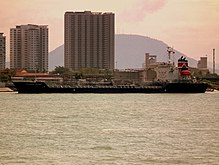Port of Penang
[7][8][9][10] The Port of Penang was then relocated to Butterworth on the mainland in 1974 to facilitate the handling of larger container vessels.
[13][14] Due to its location in the Malacca Strait along the maritime trade route between India and China, the island could be put to use as a "convenient magazine for trade"; Light added that if "Malay, Bugis and Chinese will come to reside here, it will become the Exchange of the East if not loaded with impositions and restrictions".
[16][5][17] In the early 19th century, the Port of Penang became a major conduit for spice exports in Southeast Asia.
External developments, such as the opening of the Suez Canal and the advent of steamships, meant that the Port of Penang became the first port-of-call east of the Indian subcontinent.
[21][25] Tin from the Kinta Valley and Siam were transported to George Town for smelting, before being exported via the Port of Penang to European and American industries.
[27][28] Between 1942 and 1944, George Town served as the port of call and a replenishment hub for the submarines of the Imperial Japanese Navy, the Kriegsmarine (of Nazi Germany) and the Regia Marina (of the Kingdom of Italy).
Meanwhile, Swettenham Pier, the sole remaining harbour facility in George Town, was redeveloped into a cruise shipping terminal in 2009.
[3] Meanwhile, Swettenham Pier has emerged as the busiest harbour in the country for cruise shipping, overtaking Port Klang in 2017.



